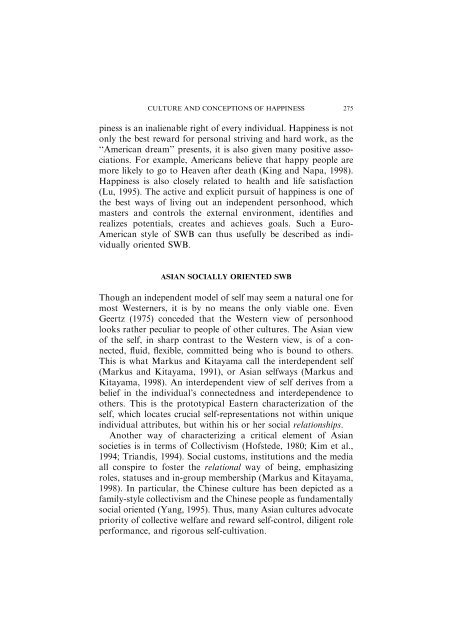CULTURE AND CONCEPTIONS OF HAPPINESS: INDIVIDUAL ...
CULTURE AND CONCEPTIONS OF HAPPINESS: INDIVIDUAL ...
CULTURE AND CONCEPTIONS OF HAPPINESS: INDIVIDUAL ...
You also want an ePaper? Increase the reach of your titles
YUMPU automatically turns print PDFs into web optimized ePapers that Google loves.
<strong>CULTURE</strong> <strong>AND</strong> <strong>CONCEPTIONS</strong> <strong>OF</strong> <strong>HAPPINESS</strong> 275piness is an inalienable right of every individual. Happiness is notonly the best reward for personal striving and hard work, as the‘‘American dream’’ presents, it is also given many positive associations.For example, Americans believe that happy people aremore likely to go to Heaven after death (King and Napa, 1998).Happiness is also closely related to health and life satisfaction(Lu, 1995). The active and explicit pursuit of happiness is one ofthe best ways of living out an independent personhood, whichmasters and controls the external environment, identifies andrealizes potentials, creates and achieves goals. Such a Euro-American style of SWB can thus usefully be described as individuallyoriented SWB.ASIAN SOCIALLY ORIENTED SWBThough an independent model of self may seem a natural one formost Westerners, it is by no means the only viable one. EvenGeertz (1975) conceded that the Western view of personhoodlooks rather peculiar to people of other cultures. The Asian viewof the self, in sharp contrast to the Western view, is of a connected,fluid, flexible, committed being who is bound to others.This is what Markus and Kitayama call the interdependent self(Markus and Kitayama, 1991), or Asian selfways (Markus andKitayama, 1998). An interdependent view of self derives from abelief in the individual’s connectedness and interdependence toothers. This is the prototypical Eastern characterization of theself, which locates crucial self-representations not within uniqueindividual attributes, but within his or her social relationships.Another way of characterizing a critical element of Asiansocieties is in terms of Collectivism (Hofstede, 1980; Kim et al.,1994; Triandis, 1994). Social customs, institutions and the mediaall conspire to foster the relational way of being, emphasizingroles, statuses and in-group membership (Markus and Kitayama,1998). In particular, the Chinese culture has been depicted as afamily-style collectivism and the Chinese people as fundamentallysocial oriented (Yang, 1995). Thus, many Asian cultures advocatepriority of collective welfare and reward self-control, diligent roleperformance, and rigorous self-cultivation.

















